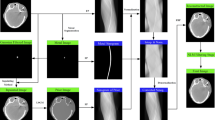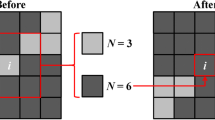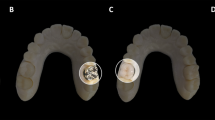Abstract
CT (computed tomography) images, metal materials such as tooth supplements or surgical clips can cause metal artifact and degrade image quality. In severe cases, this may lead to misdiagnosis. In this research, we developed a new MAR (metal artifact reduction) algorithm by using an edge preserving filter and the MATLAB program (Mathworks, version R2012a). The proposed algorithm consists of 6 steps: image reconstruction from projection data, metal segmentation, forward projection, interpolation, applied edge preserving smoothing filter, and new image reconstruction. For an evaluation of the proposed algorithm, we obtained both numerical simulation data and data for a Rando phantom. In the numerical simulation data, four metal regions were added into the Shepp Logan phantom for metal artifacts. The projection data of the metal-inserted Rando phantom were obtained by using a prototype CBCT scanner manufactured by medical engineering and medical physics (MEMP) laboratory research group in medical science at Ewha Womans University. After these had been adopted the proposed algorithm was performed, and the result were compared with the original image (with metal artifact without correction) and with a corrected image based on linear interpolation. Both visual and quantitative evaluations were done. Compared with the original image with metal artifacts and with the image corrected by using linear interpolation, both the numerical and the experimental phantom data demonstrated that the proposed algorithm reduced the metal artifact. In conclusion, the evaluation in this research showed that the proposed algorithm outperformed the interpolation based MAR algorithm. If an optimization and a stability evaluation of the proposed algorithm can be performed, the developed algorithm is expected to be an effective tool for eliminating metal artifacts even in commercial CT systems.
Similar content being viewed by others
References
J. Hsieh, Computed tomography: principles, design, artifacts and recent advances, 2nd edition, (SPIE Press, Bellingham, Wash, USA, 2009).
T. M. Buzug, Computed Tomography from Photon Statistics to Modern Cone-Beam CT (Springer, Germany, 2008).
J. F. Barrett and N. Keat, RadioGraphics 24, 1679 (2004).
W. A. Kalender, R. Hebele and J. Ebersberger, Radiology 164, 576 (1987).
S. Zhao et al., IEEE Trans. Medical Imaging 19, 1238 (2000).
M. Yazdia, L. Gingras and L. Beaulieu, Int. J. Radiat. Oncol. Biol. Phys. 64, 1224 (2005).
M. Bal and L. Spies, Med. Phys. 33, 2852 (2006).
A. C. Kak and M. Slaney, Principles of Computerized Tomographic Imaging (IEEE Press, 1988).
T. G. Feeman, The Mathematics of Medical Imaging; A Beginner’s Guide (Springer, Germany, 2010).
F. O’Sullivan, Annals Stat. 23, 1267 (1995).
E. Levitan and G. T. Herman, IEEE Trans. Medical Imaging MI-6, 185 (1987).
L. Shepp and Y. Vardi, IEEE Trans. Medical Imaging 1, 113 (1982).
G. Wang et al., IEEE Trans. Medical Imaging 15, 657 (1996).
B. De Man et al., IEEE Transactions on Nuc. Sci. 47, 977 (2000).
B. De Man et al., IEEE Trans. Med, Imaging 20, 999 (2001).
S. Larry and B. F. Logan, IEEE Trans. on Nuc. Sci. NS-21, 21 (1974).
Y. Zhang et al., Comp. and Math. Meth. In Med. 2011, 1 (2011).
Online: http://www.phantomlab.com/products/Rando.php.
J. Wei et al., Phys. Med. Biol. 49, 5407 (2004).
J. Weickert and H. Scharr, Visual Comm. and Image Rep. 13, 103 (2002).
D. Kroon and C. H. Slump, IEEE-EMBS Benelux Chapter Symposium, Enschede (2009).
D.-J. Kroon et al., MICCAI 13, 221 (2010).
F. E. Boas and D. Fleischmann, Radiology 256 894 (2011).
Y. Zhang et al., Int. J. Radiation Oncology Biol.Phys. 67, 924 (2007).
W. J. H Veldkamp et al., Med. Phys. 37, 620 (2010).
H. Yu et al., Acad. Radiol. 14, 495 (2007).
S. H. Ahn et al., Korean Phys. Soc. 64, 1220 (2014).
Author information
Authors and Affiliations
Corresponding author
Rights and permissions
About this article
Cite this article
Kim, J., Nam, H. & Lee, R. Development of a new metal artifact reduction algorithm by using an edge preserving method for CBCT imaging. Journal of the Korean Physical Society 67, 180–188 (2015). https://doi.org/10.3938/jkps.67.180
Received:
Accepted:
Published:
Issue Date:
DOI: https://doi.org/10.3938/jkps.67.180




